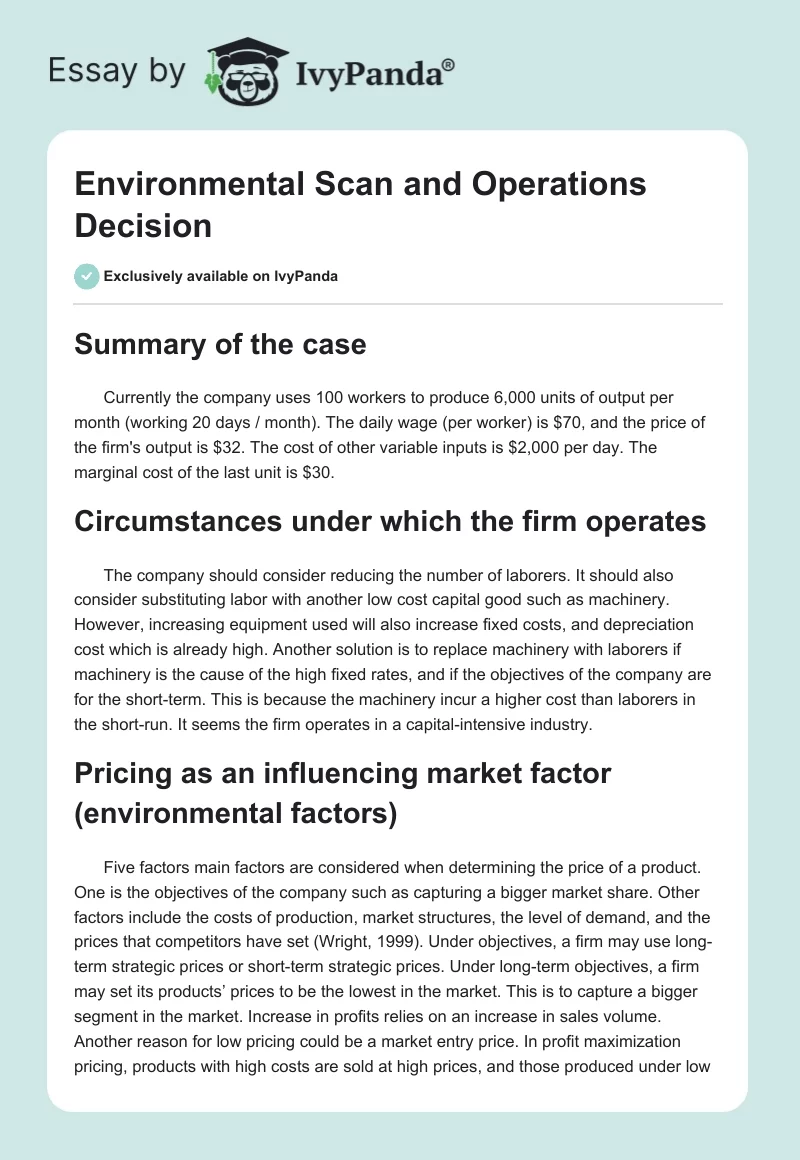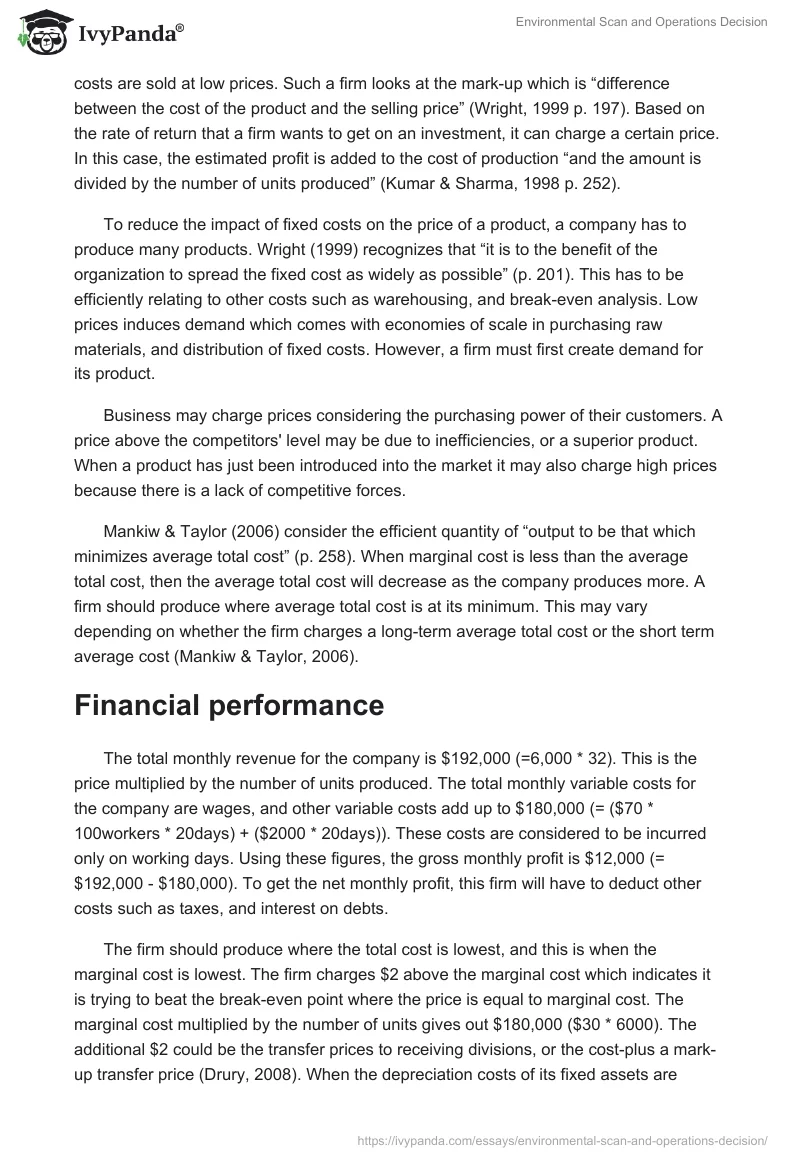Summary of the case
Currently the company uses 100 workers to produce 6,000 units of output per month (working 20 days / month). The daily wage (per worker) is $70, and the price of the firm’s output is $32. The cost of other variable inputs is $2,000 per day. The marginal cost of the last unit is $30.
Circumstances under which the firm operates
The company should consider reducing the number of laborers. It should also consider substituting labor with another low cost capital good such as machinery. However, increasing equipment used will also increase fixed costs, and depreciation cost which is already high. Another solution is to replace machinery with laborers if machinery is the cause of the high fixed rates, and if the objectives of the company are for the short-term. This is because the machinery incur a higher cost than laborers in the short-run. It seems the firm operates in a capital-intensive industry.
Pricing as an influencing market factor (environmental factors)
Five factors main factors are considered when determining the price of a product. One is the objectives of the company such as capturing a bigger market share. Other factors include the costs of production, market structures, the level of demand, and the prices that competitors have set (Wright, 1999). Under objectives, a firm may use long-term strategic prices or short-term strategic prices. Under long-term objectives, a firm may set its products’ prices to be the lowest in the market. This is to capture a bigger segment in the market. Increase in profits relies on an increase in sales volume. Another reason for low pricing could be a market entry price. In profit maximization pricing, products with high costs are sold at high prices, and those produced under low costs are sold at low prices. Such a firm looks at the mark-up which is “difference between the cost of the product and the selling price” (Wright, 1999 p. 197). Based on the rate of return that a firm wants to get on an investment, it can charge a certain price. In this case, the estimated profit is added to the cost of production “and the amount is divided by the number of units produced” (Kumar & Sharma, 1998 p. 252).
To reduce the impact of fixed costs on the price of a product, a company has to produce many products. Wright (1999) recognizes that “it is to the benefit of the organization to spread the fixed cost as widely as possible” (p. 201). This has to be efficiently relating to other costs such as warehousing, and break-even analysis. Low prices induces demand which comes with economies of scale in purchasing raw materials, and distribution of fixed costs. However, a firm must first create demand for its product.
Business may charge prices considering the purchasing power of their customers. A price above the competitors’ level may be due to inefficiencies, or a superior product. When a product has just been introduced into the market it may also charge high prices because there is a lack of competitive forces.
Mankiw & Taylor (2006) consider the efficient quantity of “output to be that which minimizes average total cost” (p. 258). When marginal cost is less than the average total cost, then the average total cost will decrease as the company produces more. A firm should produce where average total cost is at its minimum. This may vary depending on whether the firm charges a long-term average total cost or the short term average cost (Mankiw & Taylor, 2006).
Financial performance
The total monthly revenue for the company is $192,000 (=6,000 * 32). This is the price multiplied by the number of units produced. The total monthly variable costs for the company are wages, and other variable costs add up to $180,000 (= ($70 * 100workers * 20days) + ($2000 * 20days)). These costs are considered to be incurred only on working days. Using these figures, the gross monthly profit is $12,000 (= $192,000 – $180,000). To get the net monthly profit, this firm will have to deduct other costs such as taxes, and interest on debts.
The firm should produce where the total cost is lowest, and this is when the marginal cost is lowest. The firm charges $2 above the marginal cost which indicates it is trying to beat the break-even point where the price is equal to marginal cost. The marginal cost multiplied by the number of units gives out $180,000 ($30 * 6000). The additional $2 could be the transfer prices to receiving divisions, or the cost-plus a mark-up transfer price (Drury, 2008). When the depreciation costs of its fixed assets are included, then the gross profit becomes a net loss. Charging a price closer to the marginal cost indicates that the firm can be profitable if it increases the number of units it produces.
Improving profitability
Globalization offers an opportunity to spread the fixed costs by increasing the level of output for products that can be sold abroad. Drury (2008) states that a firm will “restrict output to the point where net marginal revenue equals the transfer price” (p. 519). This applies to the case where the firm is considering international transfer pricing. Going against this rule will result in no extra benefit. A firm considers marginal cost and marginal revenue to determine the point of maximum production. The long-run marginal cost should include the cost of supplying the products to outlets, and the short-term marginal cost (Drury, 2008). If the transfer costs are high for this firm then it cannot use increasing the level of output to reduce the impact of fixed costs.
Circumstances under which the firm should stop operating
The firm should continue to operate so long as the long-term objectives of the firm are profitable. If the long-run total cost exceed long-run total revenue then the firm should stop operations. In the long-run, fixed costs are spread over a long period of time. The depreciation rates are lowered as a company tends to recover a bigger portion of the amount used to purchase the fixed assets at the beginning. Some firms assign high initial depreciation rates to recover the cost of fixed. If this is the case for this firm, then it should continue operating.
The firm could be using a price closer to the marginal cost to overcome competition. In this case, it will benefit when it captures a large market share and it is able to increase its output. If the firm is already producing at its optimum output level then increasing output will result in an increase in total average cost. This will require that the company increases the price of the product to make profits or break-even. In such a situation, it is better to close operations because increasing price will be counteracting previous pricing strategy. Increasing price will result in losing the market share that had been captured. In case this is a market-entry price, then the company can easily increase prices once the product is made popular.
List of References
Drury, C. (2008). Management and Cost Accounting. London, UK: Cengage Learning EMEA.
Kumar, A., & Sharma, R. (1998). Managerial Economics. New Delhi, India: Atlantic Publishers and Distributors.
Mankiw, G. N., & Taylor, M. P. (2006) Microeconomics. London, UK: Thomson Learning.
Wright, R. (1999). Marketing: Origins, Concepts, Environment. London, UK: Thomson Learning.


